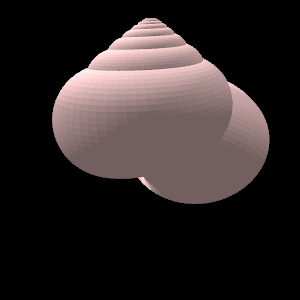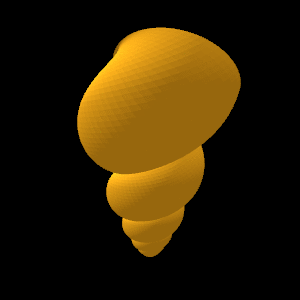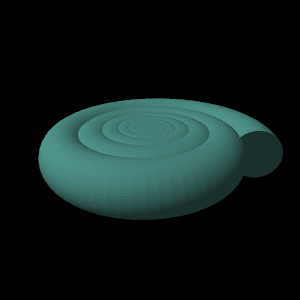use OpenGL;
#8 Seashell
This program draws a seashell.
I was inspired by the paper:
Modeling seashells [pdf] by Deborah R. Fowlery, Hans Meinhardtz and Przemyslaw Prusinkiewiczy.
Another source I recommend is the golden oldie:
D'Arcy Thompson - On growth and form (1945). (especially Chapter XI p.748~)



seashell.pl
#!/usr/local/bin/perl
#
# shell.pl : draw a seashell
# (c) 2013 jl_morel@bribes.org - http://http://bribes.org/perl
use strict;
use warnings;
use OpenGL qw/ :all /;
use Math::Trig;
#------ Base vectors
my @i = ( 1, 0, 0 );
my @j = ( 0, 1, 0 );
my @k = ( 0, 0, 1 );
my @O = ( 0, 0, 0 );
# ------ Parameters of the seashell
my $tmax = 16 * pi; # 8 rounds
my $r0 = 0.06; # initial distance to the axis.
my $kr = 0.05; # $r = $r0 * exp( $kr * $t )
my $z0 = 0.045; # initial step
my $kz = 0.075; # $z = $z0 * exp( $kz * $t )
my @Ap; # shape of the aperture (a circle here )
my $n = 32;
my $ra = 0.02; # initial radius of the aperture
my $ka = 0.08; # aperture radius = $ra * exp( $ka * $t )
for ( 0 .. 2 * $n - 1 )
{ # here the aperture is a circle (=polygon with 2*$n sides)
push @Ap, [ $ra * cos( $_ * pi / $n ), $ra * sin( $_ * pi / $n ), 0 ];
}
my @apex = ( 0, 2, 0 ); # shell apex
##--- Parametric equation of the helico-spiral
sub R {
my $t = shift;
return $apex[0] + $r0 * exp( $kr * $t ) * cos($t),
$apex[1] - $z0 * exp( $kz * $t ),
$apex[2] + $r0 * exp( $kr * $t ) * sin($t);
}
##--- First derivative
sub Rp {
my $t = shift;
return $r0 * exp( $kr * $t ) * ( $kr * cos($t) - sin($t) ),
-$z0 * $kz * exp( $kz * $t ),
$r0 * exp( $kr * $t ) * ( cos($t) + $kr * sin($t) );
}
##--- Second derivative
sub Rs {
my $t = shift;
return
$r0 * exp( $kr * $t ) * ( ($kr * $kr - 1) * cos($t) - 2 * $kr * sin($t) ),
-$z0 * $kz * $kz * exp( $kz * $t ),
$r0 * exp( $kr * $t ) * ( ($kr * $kr - 1) * sin($t) + 2 * $kr * cos($t) );
}
my $shell; # OpenGL display list for the shell
#------ Draw the shell
sub DrawShell {
my $shell = glGenLists(1);
glNewList( $shell, GL_COMPILE );
my @C0; # previous aperture circle
for ( my $t = 0 ; $t <= $tmax ; $t += 0.1 ) {
my @R = R($t);
my @T = NormalizeVector( Rp($t) ); # tangent
my @B = NormalizeVector( CrossProduct( @T, Rs($t) ) ); # binormal
my @N = CrossProduct( @B, @T ); # normal
my @C; # the current aperture circle
# in the ( @R; @T, @N, @B ) coordinate system
foreach (@Ap) {
push @C,
[
AddVectors(
AddVectors(
ScaleVector( @N, exp( $ka * $t ) * $_->[0] ),
ScaleVector( @B, exp( $ka * $t ) * $_->[1] )
),
@R
)
];
}
glBegin(GL_TRIANGLE_STRIP); # draws the band between the circles @C0 and @C
if ($t) {
for ( my $i = -1 ; $i < 2 * $n - 1 ; $i++ ) {
glNormal3d(
FindUnitNormal( @{ $C0[$i] }, @{ $C0[ $i + 1 ] }, @{ $C[$i] } ) );
glVertex3f( @{ $C0[$i] } );
glVertex3f( @{ $C[$i] } );
glVertex3f( @{ $C0[ $i + 1 ] } );
glVertex3f( @{ $C[ $i + 1 ] } );
}
}
glEnd();
@C0 = @C; # for the next step
}
glEndList;
return $shell;
}
#------ Draw the scene
my $spin = 0; # rotation angle
sub display {
glClear( GL_COLOR_BUFFER_BIT | GL_DEPTH_BUFFER_BIT );
glLoadIdentity();
gluLookAt( 2, 4, 10, 0, 0, 0, 0, 1, 0 );
glPushMatrix();
glScalef( 1.9, 1.9, 1.9 );
glRotatef( $spin, -sqrt(2) / 2, sqrt(2) / 2, 0 );
glCallList($shell); # draw the shell
glPopMatrix();
glutSwapBuffers();
# debug code
# if ( ( my $e = glGetError() ) != GL_NO_ERROR ) {
# print "error : ", gluErrorString($e), "\n";
# }
}
#------ Initialization routine
# pearl
my @mat_ambient = ( 0.25, 0.20725, 0.20725, 0 );
my @mat_diffuse = ( 1, 0.829, 0.829, 0 );
my @mat_specular = ( 0.296648, 0.296648, 0.296648, 0 );
my $shininess = 0.088 * 128;
sub init {
glClearColor( 0, 0, 0, 0 ); # Black background
glShadeModel(GL_SMOOTH); # Smooth shading
glEnable(GL_MULTISAMPLE); # Enable multisample antialiasing
glEnable(GL_DEPTH_TEST); # Enable hidden surface removal
glEnable(GL_LIGHTING);
my @light_diffuse = ( 0.8, 0.8, 0.8, 1.0 );
my @light_ambient = ( 0.8, 0.8, 0.8, 1.0 );
my @light_specular = ( 0.5, 0.5, 0.5, 1.0 );
# set light 0
glEnable(GL_LIGHT0);
my @light0_position = ( -20.0, 20.0, 0.0, 0 );
glLightfv_p( GL_LIGHT0, GL_POSITION, @light0_position );
glLightfv_p( GL_LIGHT0, GL_DIFFUSE, @light_diffuse );
glLightfv_p( GL_LIGHT0, GL_AMBIENT, @light_ambient );
glLightfv_p( GL_LIGHT0, GL_SPECULAR, @light_specular );
# set light 1
glEnable(GL_LIGHT1);
my @light1_position = ( 10.0, 50.0, 0.0, 0 );
glLightfv_p( GL_LIGHT1, GL_POSITION, @light1_position );
glLightfv_p( GL_LIGHT1, GL_DIFFUSE, @light_diffuse );
glLightfv_p( GL_LIGHT1, GL_AMBIENT, @light_ambient );
glLightfv_p( GL_LIGHT1, GL_SPECULAR, @light_specular );
# set material
glMaterialfv_p( GL_FRONT, GL_AMBIENT, @mat_ambient );
glMaterialfv_p( GL_FRONT, GL_DIFFUSE, @mat_diffuse );
glMaterialfv_p( GL_FRONT, GL_SPECULAR, @light_specular );
glMaterialf( GL_FRONT, GL_SHININESS, $shininess );
$shell = DrawShell();
}
#------ GLUT Callback called when the window is resized
sub reshape {
my ( $w, $h ) = @_;
glViewport( 0, 0, $w, $h );
glMatrixMode(GL_PROJECTION);
glLoadIdentity();
gluPerspective( 45, $h ? $w / $h : 0, 1, 20 );
glMatrixMode(GL_MODELVIEW);
glLoadIdentity();
}
#------ Routine for rotating the scene
my $WaitUntil = 0;
sub spinDisplay {
my $TimeNow = glutGet(GLUT_ELAPSED_TIME);
if ( $TimeNow >= $WaitUntil ) {
$spin += 1;
$spin = $spin - 360 if ( $spin > 360 );
glutPostRedisplay();
$WaitUntil = $TimeNow + 1000 / 25; # 25 frames/s
}
}
#------ GLUT callback for the mouse
sub mouse {
my ( $button, $state, $x, $y ) = @_;
if ( $button == GLUT_LEFT_BUTTON ) {
glutIdleFunc( \&spinDisplay ) if ( $state == GLUT_DOWN );
}
elsif ( $button == GLUT_RIGHT_BUTTON ) {
glutIdleFunc(undef) if ( $state == GLUT_DOWN );
}
}
#------ Main program
glutInit();
glutInitDisplayMode(
GLUT_DOUBLE # Double buffering
| GLUT_RGB # RGB color mode
| GLUT_DEPTH # Hidden surface removal
| GLUT_MULTISAMPLE # Multisample antialiasing
);
glutInitWindowSize( 300, 300 );
glutCreateWindow("Seashell");
init();
glutDisplayFunc( \&display );
glutReshapeFunc( \&reshape );
glutMouseFunc( \&mouse );
glutIdleFunc( \&spinDisplay );
glutMainLoop();
# ============ Some 3D math routines
#------ Returns the cross product of 2 vectors
sub CrossProduct {
return (
$_[1] * $_[5] - $_[2] * $_[4],
$_[3] * $_[2] - $_[0] * $_[5],
$_[0] * $_[4] - $_[1] * $_[3]
);
}
#------ Returns the length of a vector
sub GetVectorLength {
return sqrt( $_[0] * $_[0] + $_[1] * $_[1] + $_[2] * $_[2] );
}
#------ Returns the sum of two vectors
sub AddVectors {
return ( $_[0] + $_[3], $_[1] + $_[4], $_[2] + $_[5] );
}
#------ Returns the vector scaled by the last parameter
sub ScaleVector {
return ( $_[0] * $_[3], $_[1] * $_[3], $_[2] * $_[3] );
}
#------ Returns a normalized vector (length = 1)
sub NormalizeVector {
return ( 0, 0, 0 ) if ( my $norm = GetVectorLength(@_) ) == 0;
return ScaleVector( @_, 1 / $norm );
}
#------ Returns the unit normal vector of a triangle specified by the three
# points P1, P2, and P3.
sub FindUnitNormal {
return NormalizeVector(
CrossProduct(
$_[0] - $_[3], $_[1] - $_[4], $_[2] - $_[5], # P1-P2
$_[3] - $_[6], $_[4] - $_[7], $_[5] - $_[8] # P2-P3
)
);
}
The script as .txt for download:
seashell.pl.txt
Back to Top
BðP © 2013 J-L Morel - Contact : jl_morel@bribes.org
![[Validation HTML 4.0!]](vh401.gif)


